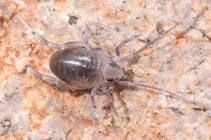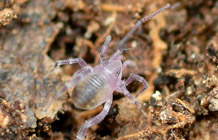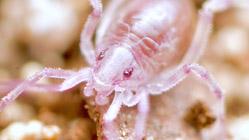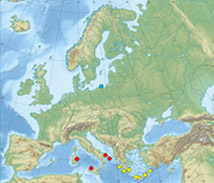 |
Slovak Arachnological Society |
|
Opilioacarida |
|
|
Opilioacarida • Holothyrida • Ixodida • Mesostigmata • Trombidiformes • Sarcoptiformes |
|
 |
Slovak Arachnological Society |
|
Opilioacarida |
|
|
Opilioacarida • Holothyrida • Ixodida • Mesostigmata • Trombidiformes • Sarcoptiformes |
|
According Walter (2006)
opilioacarids are soft-bodied, grey-blue to lilac in colour, usually with white bands or stripes.
Opisthosoma bearing four pairs of dorso-lateral spiracles, prosoma with 2-3 pairs of lateral ocelli.
Gnathosoma bearing >4 pairs of ventral setae, rutella and With’s organ, tritosternum unfused.
Chelicerae 3-segmented; palps 5-segmented [see original source].
Opilioacarids are known to live in different environmental conditions (bark trees, litter, caves, humid and arid places) but most species were reported only from one environment (de Araújo et al. 2018b).
Opilioacarida comprises 1 family, 13 genera, and 47 valid species
(Schmidt 2010,
Vázquez et al. 2020).
 |
 |
 |
 |
Neocarus, Mexico (© Andy Murray) |
Neocarus, Arizona [© Chris Joll] |
Neocarus, Texas (© Robert Deans) |
Neocarus, Mexico (© Andy Murray) |
The geographical distribution of the Opilioacarida order comprises several places: Mexico, Texas and Arizona (North America); Panama, Nicaragua, Belize, Puerto Rico, Cuba, Dominican Republic, and according Beron (2018) also Honduras (Central America); Venezuela, Brazil, Uruguay, and Argentina (South America); Italy and Greece (Europe); Algeria, Ivory Coast, Gabon, Angola, Tanzania, Madagascar, South Africa, and according Beron (2018) also Mozambique (Africa); Yemen, India, Thailand, Kirgyzstan, and according various authors also Uzbekistan (Krivolutsky 1965) and Kazakhstan (van der Hammen 1968b) (Asia). The only known Australian representative of the group is currently undescribed, but has been collected in the Kimberleys, Kakadu, and Far North Queensland (Walter & Proctor 1998, Walter 2006).
Only a few opilioacarid species have wider distribution. The north temperate species Neocarus texanus, may have a very broad range, from Central Texas, west to Arizona (both U.S.A.), and south to Guerrero, Mexico (Vázquez & Klompen 2015), sites separated by more than 1000 km (Vázquez et al. 2020). On the other hand, the record of Opilioacarus italicus presented by Krivolutsky (1965) cannot be identified as the species O. italicus due to the poorly described characters; its geographic (100 km northeast from Tashkent, Uzbekistan, more than 4,800 km from the locus typicus in Italy) suggests it is not O. italicus (de Araújo et al. 2018b).
 |
Europe. After its description in the early twentieth century (With 1904), Opilioacarus italicus was collected only once by Brignoli (1967). Brignoli collected and identified material from different parts of Italy (Sardinia and Apulia), and used it to re-describe O. italicus, a species described from Sicily. Unfortunately, all information presented can be applied to almost all opilioacarid genera, making a proper identification impossible. In addition, Brignoli did not check the holotype. Type for O. italicus (a single immature damaged specimen) was not found. So it is assumed that it is lost. Efforts to recollect specimens from the type locality were unsuccessful. In absence of an O. italicus type and with its description that does not provide sufficient characters for a proper identification, de Araújo et al. (2018b) consider O. italicus as a nomen dubium, pending the collection of new material from the type locality and designation of a neotype. |
Brignoli’s material becomes impossible to confirm with Opilioacarus italicus, so de Araújo et al. (2018b) described a new species Opilioacarus brignolii. Type localities where O. brignolii specimens were collected are separated by almost 600 km and by the Tyrrhenian Sea. The type locality for O. italicus is also 600 km apart from the two type localities of O. brignolii (still separated by the Tyrrhenian Sea). These distances and the similar geographical barriers indicate O. brignolii could be a junior synonym of O. italicus (de Araújo et al. 2018b). The first known opilioacarid described from Algeria (With 1902), Opilioacarus segmentatus, was found on the Greek island of Corfu shortly after its description (Silvestri 1904). Other published findings followed – Peloponnese Peninsula (Lüdicke & Madel 1937, Thaler & Knoflach 2003); islands Kasos, Karpathos, and Rhodos in Aegean Sea (Beron 1990), and Crete Island (Thaler & Knoflach 2003, Dunlop & Bernardi 2014).